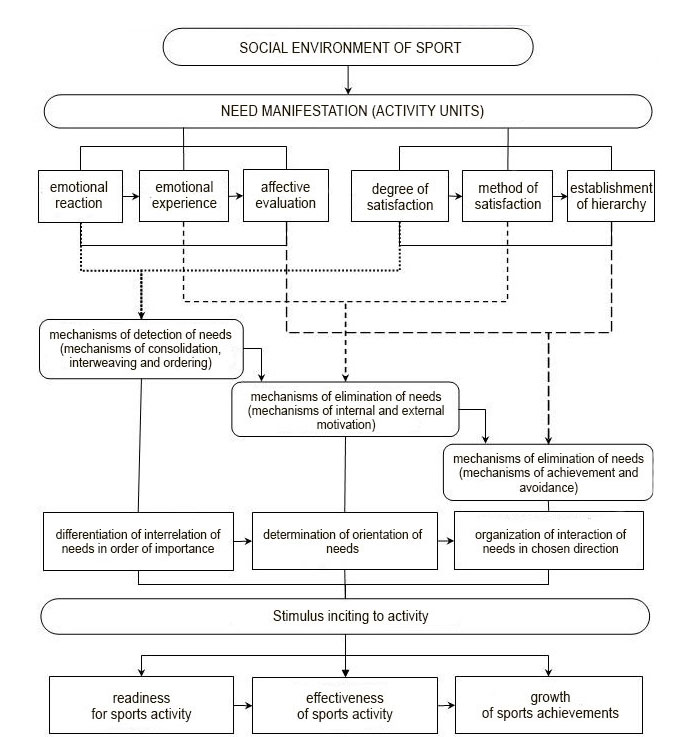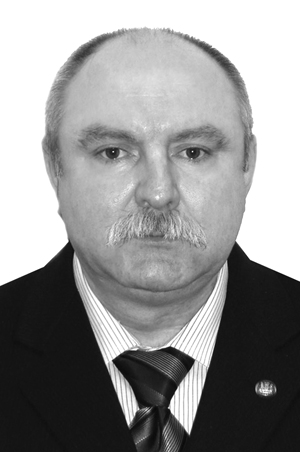Model of Satisfaction of Social Needs in Sports Activity
Фотографии:
ˑ:
B.P. Yakovlev, professor, Dr.Sc.Psych.
Surgut state university KhMAR-Yugra, Surgut
G.D. Babushkin, professor, Dr.Hab.
N.S. Niyasova, associate professor, Ph.D.
Siberian State University of Physical Culture and Sport, Omsk
Key words: sports activity, model of satisfaction of social needs, mechanisms and function of need.
The study is relevant due to, on the one hand, high importance of human needs in choosing sport and sports improvement, on the other hand, lack of knowledge about the mechanisms of satisfaction of needs and control of this process. In sports science the problem of satisfying the biological and social needs [7] is being studied, but it is important not only to meet the current needs of those involved in sport, but also purposefully control their formation in young athletes at early phases of their occurrence. Thus, it is crucial to form in young athletes the needs for sports knowledge, achievement, belonging, recognition and others that contribute to sports improvement [1].
Despite the existing concepts of human need reduction in the course of man’s activity [8, 11], their fragmentation, conceptual and terminological inconsistency, lack of integrating concepts and ideas are observed. Such a state of the range of problems of satisfaction of human needs in the course of his activity makes particularly relevant not only accumulation to allocate the problem - managing the satisfaction of social needs of a person engaged in professional sport and formation of important needs in young athletes.
The purpose of the present study was to develop a conceptual model of human social needs for sports activity.
Results and discussion. The model of satisfaction of social needs in sport is a self-organizing system of mechanisms of detection and elimination of needs, which functions in terms of interaction of an organism (man) and environment (sport) and predetermines a person's sports activity. The goal of development of the model of satisfaction of needs was not only to explain the characteristics of need and the mechanisms of its satisfaction, but also to predict need manifestations (interrelation and interaction of activity units) within the system of the long-term training of athletes, which are of particular research interest, and which enable athletes' readiness for a prolonged sports activity and growth of sports results.
The schematic representation of the model of satisfaction of social needs in sports activity reflects the interaction of man and sport, during which needs are seen in different forms (consolidation, interweaving and ordering) depending on the progressive development of the mechanisms of their satisfaction (Diagram ).

Diagram. Model of satisfaction of social needs in sports activity
Firstly, it means that consolidation of activity units of a person, which exists as the actual fact of functioning of the need detection mechanisms, is to be taken into consideration when analyzing the determinants of a person’s athletic performance in sports activity and, what is most significant for sports specialists, can characterize a person’s readiness for a prolonged sports activity. Readiness for sports activity is a motivational disposition for specific actions, and it consists in the person’s ability to reflect reality, and with that anticipate the actual course of events, and basing on this reflection control own activity.
Control over a person’s activity within the challenging social environment of sport involves subjective characteristics that help estimate the emotional level of his readiness for high sports achievements: emotional reaction, emotional experience and affective evaluation.
Reality reflection involves objective characteristics that reveal the need level of the person’s readiness for prolonged sports activity: degree of need satisfaction, method of need satisfaction and establishment of the hierarchy of needs. These indicators of the emotional and need triads are interrelated and function simultaneously, acting as a person’s emotional-need activity.
Secondly, activity units, interwoven in a fixed order by means of progressive development of the mechanisms of detection and elimination of needs, may provide the basis for the pedagogical characteristic of the effectiveness of sports activity of each particular athlete.
Needs are satisfied by way of emotional experiences (pleasure, joy, confidence, satisfaction). These feelings precede the corresponding activities, incite to them and are responsible for orientation of needs. It is the ability to go through emotional experiences that determines the orientation of needs, and predetermines the choice of the method of satisfaction of needs (desire, motivation, drive, stimulation). For instance, the need for action which is common in sport is experienced as pleasure and is satisfied in the form of a desire, and the need for achievement is experienced as confidence and is satisfied in the form of achievement drive. Thus, it can be asserted that the effectiveness of sports activity is determined by the method used to satisfy needs, chosen individually based on experienced positive emotions [11].
Thirdly, activity units become ordered due to the mechanism of achievement, when for the purpose of their satisfaction some needs involve other ones (as a rule, more general ones), which explains why needs interact in the chosen direction of success achievement. Ordering of activity units is typical for all levels of development of need and implies the phases of their consolidation and interweaving. At the first phase, some activity units determine the development of need at the level of detection of need, they are consolidated into the emotional triad and contribute to the control over a person’s activity, with participation of an individual himself, making him change his attitude towards one kind of stimuli under the influence of other ones. The rest of activity units are consolidated into the need triad and provide the development of need at the level of elimination of need, and function as reality reflection.
The specific function of the emotional triad is to regulate subject’s activity in a particular situation, which helps develop new, not preprogrammed reactions. Available experience is used when developing emotional reactions, and the experience accumulated under current conditions – emotional experience in the form of dissatisfaction and affective evaluation in the form of selection, combination, verification and correction – is not applied automatically, but on the basis of tentative processes [4], with the actively involved subject himself. It is manifested as a subject’s ability to pursue goals [3] or as “a vision of the needed future” [2].
The possibility to develop reactions depending on the situation, according to the psychic reflex concept offered by I.M. Sechenov [9] and elaborated later in the activity theory by A.N. Leont'ev [6], is ensured by the contracted internal activity (i.e. without any visible actions), aimed at transformation of the situation in the chosen direction (as a rule, at success achievement). As a result, a wide range of potential activities [5] emerges within an individual's mental model, by selecting and replaying which he can plan his activity, which would comply with the current situation. With such understanding of the primitive level of development of need in sports activity (level of need detection), the connection between the structural elements "emotional reaction - emotional experience - affective evaluation" contributes to the regulation of a subject's activity within a challenging social environment of sport and directs athlete's actions to detect needs (actualization of need) in the form of the desire to derive pleasure.
Referring to the experience in social background, an individual gains the capacity to reflect the occurring events in the context of the integral "world image" [10] - a system of the traditional concept of reality, own self and his role in it. Automated identification of the reflected events within such system, that puts an individual particularly to their characteristics and connections with other phenomena, provides special nature of the reflexive image in a man's psyche - consciousness. In sports activity this system of reflexive image of reality is due to the connection between activity units - degree of satisfaction of need, method of satisfaction of need, establishment of the hierarchy of needs.
In the given vision of the level of elimination of need, the connection between the structural elements that characterize the degree of satisfaction of need, method of satisfaction of need and establishment of the hierarchy of needs, provides reality reflection with the anticipation of the actual course of events (according to L.S. Vygotsky – self-reflection). Self-reflection provides the formation of the drive for meaningful goals in sports activity and directs an athlete’s behavior so that his needs were satisfied (eliminated) [7].
Conclusion. The presented model of social needs satisfaction in sports activity, on the basis of the progressive development of mechanisms of need manifestation helps explain the sequence and simultaneity of consolidation, interweaving and ordering activity units, which determines readiness for prolonged sports activity in young athletes and increase of athletic performance in skilled athletes.
References
- Babushkin, G.D. Intellectual and psychological training of athletes / G.D. Babushkin, K.V. Dikikh. - Omsk: SibSUPC, 2013. – 240 P. (In Russian)
- Bernstein, N.A. Essays on the physiology and kinesiology of activity / N.A. Bernstein. – Moscow: Meditsina, 1966. – 349 P. (In Russian)
- Vilyunas, V.K. Instinct in the light of the emotional concept of motivation / V.K. Vilyunas // Vestnik Mosk. un-ta. Ser. 14. Psychology. – 1997. – № 1. – P. 3–13, 91–92. (In Russian)
- Gal'perin, P.Ya. Psychology of thinking and the teaching about the gradual formation of mental actions / P.Ya. Gal'perin // Researches of thinking in Soviet psychology. – Moscow: Nauka, 1966. – P. 236–277. (In Russian)
- Levin, K. Field theory in social sciences / K. Levin. – St. Petersburg: Sensor, 2000. – 368 P. (In Russian)
- Leont'ev, A.N. Activity. Consciousness. Personality / A.N. Leont'ev. – Moscow: Uchpedgiz, 1975. – 304 P. (In Russian)
- Niyasova, N.S. The structure and essence of social and personal values of physical culture and sport / N.S. Niyasova // Omsky nauchny vestnik. – 2008. – № 1 (63). – P. 101–104. (In Russian)
- Nutten, J. Motivation / J. Nutten // Experimental Psychology. – Iss. 5. – Moscow: Progress, 1975. – P. 15–101. (In Russian)
- Sechenov, I.M. Selected Works / I.M. Sechenov. – Moscow: Uchpedgiz, 1953. – 336 P. (In Russian)
- Smirnov, S.D. The concept of "world image" and its importance for psychology of cognitive processes / S.D. Smirnov // Leont'ev A.N. and modern psychology. – Moscow: Pub. h-se of MSU, 1983. – P. 149–155. (In Russian)
- Yakovlev, B.P. Motivation and emotions in sport / B.P. Yakovlev. – Moscow: Sovetsky sport, 2014. – 312 P. (In Russian)
Corresponding author: apokin_vv@mail.ru



